#court de gebelin
Text
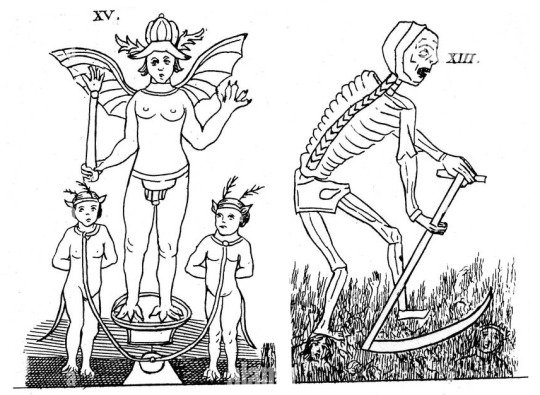
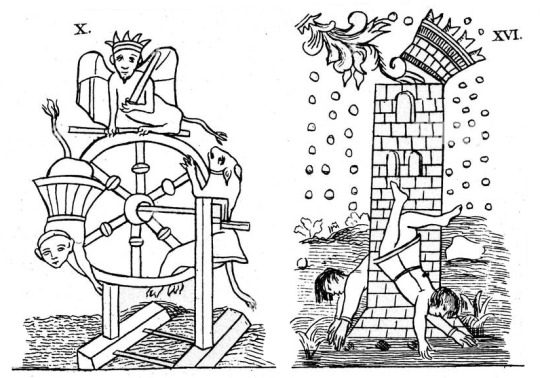
Tarot card figures from Court de Gebelin's Monde
primitif (1781): the Devil; the Death; the Wheel; the Tower.
123 notes
·
View notes
Text
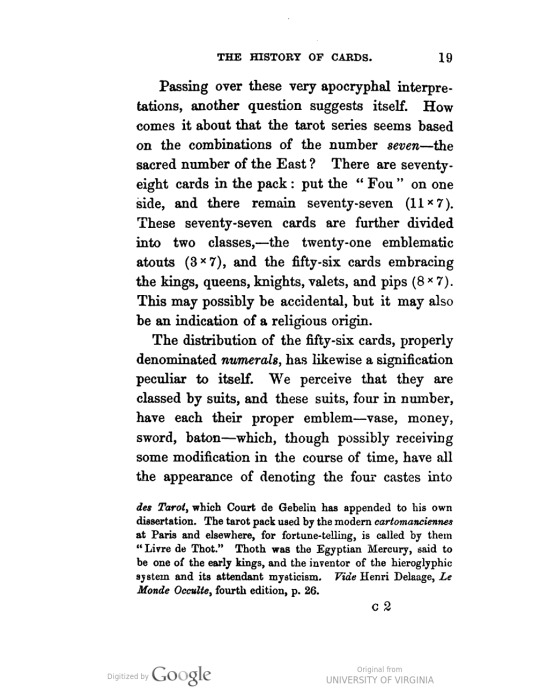
Taylor, E. Samuel., Hotten, J. Camden. (1865). The history of playing cards: with anecdotes of their use in conjuring, fortune-telling, and card-sharping.London: Hotten.
2 notes
·
View notes
Text
History of Tarot

View On WordPress
#Alchemy#aleister crowley#aliens#archetypes#arthur edward waite#Astrologer#Astrology#Atlantis#books#chakras#consciousness#court de gebelin#crowley#deities#egyptian gods#Esoteric#freemason#History#history of tarot#kabbalah#Kundalini#Labyrinth#lakin#les tarots#Magic#Magick#Meditation#Metaphysical#mysterious#Mystery
4 notes
·
View notes
Note
How do cards gain meaning in an occult sense? Like, both tarot and french-suited playing cards started as game pieces, but they have gained an understood meaning. Is it just someone whips up an organized table of connected ideas or is each card interpreted from a certain framework?
Oh good question!
Many things that we now consider staples of western magic are ideas that have been added to over generations by several layers of thinkers. Tarot Divination specifically is an excellent example of this!
In 1770, A french printmaker and occultist going by Etteilla published a book about how to do cartomancy with a 32-card Piquet deck. He writes down some simple but strict associations for the cards, and makes what is probably the first mention of reversals in carotmancy. He said that he learned the system "from an Italian." Now, its unclear how much of the system is his own invention, people have been doing cartomancy for as long as there's been cards, but the text presents a larval, bare-bones version of the cartomancy methods we know and love today.
Its 1780-ish. The Rosetta stone hasn't been discovered yet. Occult-inclined Europeans are obsessed with Egypt. That's where our boy Trismegistus is from! There's a concept in Egyptian mythology called The Book of Thoth, a mythical book of spells penned by the God of Knowledge himself. This was the Holy Grail for European Occult Egpytaboos.
In 1781, Antoine Court de Gébelin claimed that Tarot cards were the "original book of Thoth," Saying that Tarot cards had been used by ancient Egyptian priests for their own magical ceremonies, and that their designs contained ancient mystical secrets. This is 100% not true, but he writes a pretty fun pseudohistory for Tarot that involves Romani people bringing the decks to Europe through the Levant where they then taught its esoteric secrets to several Popes.
Then in 1783, Ettellia responded with another book. Manière de se récréer avec le jeu de cartes nommées tarots ("Way to recreate yourself with the deck of cards called tarots") Where Ettellia basically claims "uhm actually I knew about tarot divination way before Court de Gebelin published that big ass book. But anyway here's an interpretation of Tarot symbology that includes multiple references to Egyptian, Zoroastrian, and Greek mythology." But the smartest thing he did was include spread methods that involved Thoth and Numerology. Napoleonic Occultists fucking loved Thoth and numerology.
In 1788, he formed a little magical society for the express purpose of discussing and workshopping ideas for Tarot divination. In 1789, he made a TRULY smart decision, and published a Tarot deck that was Specifically For Magic, and that basically cemented Tarots place in magical history.
Occultists just kept iterating! Someone would speculate "maybe the suits correspond to the elements" and people went "yeah, they correspond to the elements! That makes this tool even more fun and interesting to use!" Then people go "What if the suits and the elements also correspond to parts of the Self?" and people went "Sure they do! That makes this tool even more interesting!"
But its also not just one thread. Eventually you get the Golden Dawn saying "The Major Arcana correspond to the nodes and paths on our version of the Quabbalistic Sefirot, you know, the hermetic version with a Q." and some occultists responded "Idk about that! Love what you've done with the color symbology though!"
The development of magical ideas is an iterative process. It is people whipping up a table of correspondences, but that table needs a mythology to keep it together. Originally, the mythology that gave tarot "power" was its Egyptian pseudohistory, but these days its the fact that occultists have been iterating on and fine-tuning this system for hundreds of years.
Humans don't think in tables of information, they think in stories. The cool thing about stories is that they're flexible. If magic is anything, its learning how to engineer stories to make the tables of information more effective.
I'm gonna plug my patreon where I post all of my occult research if you wanna see more stuff like this
#Tarot#Occult#I was supposed to edit today but I couldn't pass up this opportunity for a micro essay#cartomancy
3K notes
·
View notes
Note
The fun facts are back! Can I get one please?
I keep thinking of that well-meaning anon from a few weeks back, so I’m going to say Today You Learned about THE MAN WHO RUINED TAROT
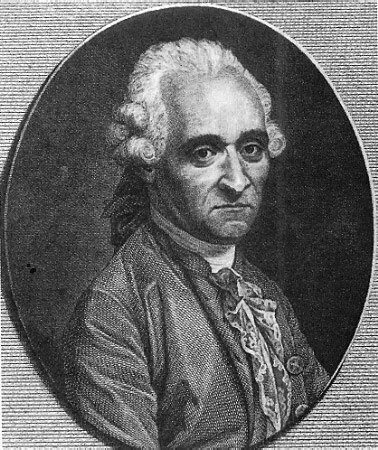
YOU
Antoine Court de Gebelin. But let’s back up.
Tarot is a card game. That is all it was ever meant to be–it was a card game for hundreds of years, and in some places it remains a card game to this day. Then along comes Antoine Court. The man was a Swiss Freemason, formerly a religious pastor, and was apparently well-regarded as a scholar. Due to his support for American Independence, he was given honorary membership to the American Philosophical Society in 1783, when we were a brand spanking new country.
However! He was also interested in the occult, and as the theme for the night apparently is, occultists often ruin things. When he saw tarot cards, something often associated with the Romani people, and saw that they were marked with symbols he didn’t understand, Antoine decided that, naturally, they must be ancient Egyptian symbols, and therefore MAGIC. Because back then they decided everything ancient Egyptian might be MAGIC.
Okay, see, part of the thing is that there was this common perception that the Romani were Egyptian, or descended from them, hence that term for them that they don’t like very much. And remember that people couldn’t read Egyptian hieroglyphics yet–the Rosetta Stone wasn’t discovered and decoded until later, so for all people knew, Egyptian writing could be magic (though that still seems pretty silly to me).
So Antoine came up with a full backstory for these cards, and that they could see the future, and that the symbols were just brimming with occult significance, and now people use tarot cards to tell the future.
For some reason.
Look, it’s nonsense. Tarot cards aren’t a magical tradition carried down from ancient Egypt, that’s a different children’s card game–Duel Monsters. But because this one guy decided “AKSHUALLY, they must be EGYPTIAN!!1!”, and then other occultists ran with it, and packaged it as a trendy way to see the future/make money, what is supposed to be a simple game has warped into this weird occult phenomenon.
Ugh.
65 notes
·
View notes
Note
heyyy, good natured question here: because i kind of think ignoring how incredible the tarot system built by waite is, just because it uses symbols from different religions is quite limiting. when i compared pre waite decks to his creation there really is s lot that doesnt quite have as much meaning. i feel like a lot of the pre golden dawn decks are more focused on mundane and fortune telling. while waites system is actually very mystical and its more of a system than what ive observed otherwise. this is just my own pbservation but i wonder what you think about it. i of course would neever propose any deck to a person who feels uncomfortable with what it depicts, especially when it concerns religions. but i feel like a lot of the new hip and aesthetic tarots kind of miss out on a whole lot of mysticism, symbolism and meaning. they become a bit watered down if you know what i mean? wonder if anyone else feels this way
Oooo, let me get my Witchstorian hat....because there is some TEA here.
The association of tarot cards with various types of mysticism goes back to 18th-century France. The decks existed in Italy before then, as playing cards for various types of trump-style games, some of which are still played on the peninsula today. A French scholar by the name of Antoine Court de Gebelin, who is considered the grand-daddy of many later occultist philosophies, published a piece in 1781 on the allegedly-ancient origins of the symbols on tarot cards. He claimed that Ancient Egyptian priests had encoded their sacred text, The Book of Thoth, into tarot cards and that if a person knew how to read the symbols properly, they could unlock all of human knowledge.
Fun Fact: Gebelin knew precisely jack shit about Ancient Egypt. The language on the ancient papyri hadn't even been translated yet when he put forth these ideas (and once it was, none of it supported his claims). But Gebelin was very popular and he was a white guy in colonial academia, so nobody was asking inconvenient questions.
The same year, another French guy wrote an essay that posited that one could map the 22 Major Arcana cards onto the 22 letters of the Hebrew alphabet. This eventually led to members of the Hermetic Order of the Golden Dawn creating the Rider-Waite deck with Hebrew lettering and the tetragrammaton, because they were Ob.Sessed. with Jewish mysticism even though none of them were actually Jewish.
The Order created the first modern standard set and the rules for reading them in 1909-1910, and these were later expanded upon by Eden Gray in the 1960s, which gives us the tarot as we know it today.
There's a lot more to the story of tarot than this, but that's the TL;DR version of how the cards became mystical and why some decks include Jewish symbols. Which, quite frankly, they shouldn't, mystical associations or no.
If you're interested in the full story, you can check out the August 2021 episode of my podcast, Hex Positive - "The Trouble With Tarot." I wrote it in response to a then-prevalent argument that tarot originated with the Romani people and that the use of the cards was culturally protected. (Spoiler alert: they didn't and it's not, but I do address the connection in the episode.)
Personally, I don't feel like artistic decks water down the practical use of the cards anyway, but I do find that people connect more strongly to some decks. I love my Visconti-Sforza deck with its' classical artwork and old symbols, and I love my Golden Nouveau deck with all the flowery, flowy paintings. And I learned to read on the Faery Wicca tarot deck, which is exactly as fluffy and ridiculous as it sounds, but I love that one too.
So really, I think it's all a matter of personal preference. If the artwork and symbolism in a deck doesn't resonate with you, that's probably going to feel kind of useless to you personally. But somebody else might pick it up and go, "Wow! This is exactly what I've been looking for!" and have great success with their readings. To each their own.
Hope this helps!
120 notes
·
View notes
Text
Occultism - A Brief History and Rundown
While the term “occult” has come to be used socially as an all-encompassing label for witchcraft, paganism, and old age spiritualism, the truth is a lot more complex than many think.

What Does It Mean?
Occult - Category of esoteric supernatural beliefs (and accompanying practices) that generally fall outside the world of organized religion and science
Due to this definition, it’s easy to understand how “occult” has become a term used to describe magic, witchcraft, and all forms of paganism. However, this absolutely is not the case.
History
“Occult sciences” was a term first used in 16-century, ambiguous Europe. It was used to refer to three specific practices, those being alchemy, astrology, and “natural magic”. The term significantly took off during 19th-century France with figures as as Antoine Court de Gebelin (former Protestant pastor, credited with initiating the interpretation of Tarot cards as a means to find wisdom beyond our reach).
Occult Sciences
Occult sciences (again, a term first developed in the 16th-century) encompasses three practices:
Alchemy
“...a form of speculative thought that, among other aims, tried to transform copper into silver or gold and to discover a cure for disease and a way of extending life” -Britannica
Astrology
“...type of divination that involves the forecasting of earthly and human events through the observation and interpretation of the fixed stars, the Sun, the Moon, and the planets” -Britannica
“Natural Magic”
Deals with natural forces directly, opposed to ceremonial magic (which tends to deal with the summoning of spirits)
These practices were grouped together because “each one of them engaged in a systematic investigation of nature and natural processes, in the context of theoretical frameworks that relied heavily on a belief in occult qualities, virtues, or forces” -Wouter Hanegraaf (Dutch hermeticism scholar).
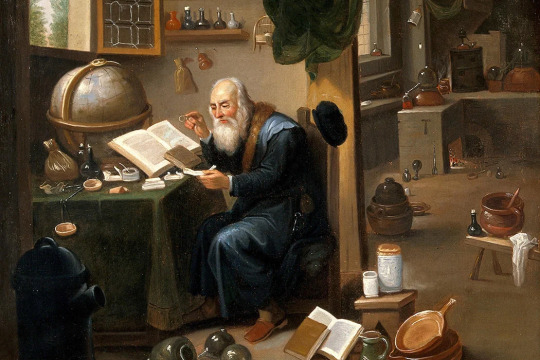
Occultism and Notable Figures
Within the English-speaking world, notable figures inside the development of occultism included Helena Blavatsky (Russian mystic who co-founded the Theosophical Society), senior members and figureheads of the Hermetic Order of the Golden Dawn (William Westcost, Samuel Liddell MacGregor Mathers), and Aleister Crowley (perhaps one of the most famous English occultists).
Different from older forms of esotericism, occultism doesn’t reject “scientific progress” or the notion of “modernity”. It was broadly believed by many that there was a need to solve the conflict often found between religion and science, something also believed could be solved through the studying of occultism. Due to this, occultism should be viewed as a radical form of social reform that aimed to establish new forms of “scientific religion” while also propagating the revival of an ancient tradition of “true religion”.
Another notable characteristics of occultists is that, also unlike earlier esotericists, that openly distance themselves from Christianity. In some cases, particularly seen in Aleister Crowley, they developed and/or adopted anti-Christian stances. In their efforts to reject Christianity, many occultists turned to pre-Christian belief systems (modern Paganism, Buddhism, Hinduism).
10 notes
·
View notes
Photo
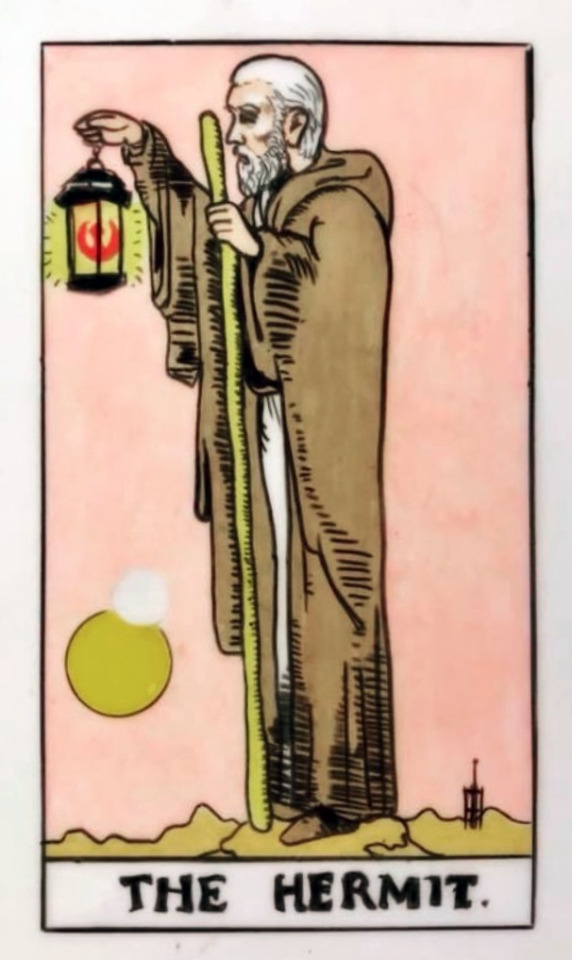
The Hermit. Art by Jeremy Ennis, from the Star Wars Tarot.
The variation from the conventional models in this card is only that the lamp is not enveloped partially in the mantle of its bearer, who blends the idea of the Ancient of Days with the Light of the World It is a star (rebel) which shines in the lantern. I have said that this is a card of attainment, and to extend this conception the figure is seen holding up his beacon on an eminence. Therefore the Hermit is not, as Court de Gebelin explained, a wise man in search of truth and justice; nor is he, as a later explanation proposes, an especial example of experience. His beacon intimates that "where I am, you also may be." “The truth from a certain point of you”
It is further a card which is understood quite incorrectly when it is connected with the idea of occult isolation, as the protection of personal magnetism against admixture. This is one of the frivolous renderings which we owe to Éliphas Lévi. It has been adopted by the French Order of Martinism and some of us have heard a great deal of the Silent and Unknown Philosophy enveloped by his mantle from the knowledge of the profane. In true Martinism, the significance of the term Philosophe inconnu was of another order. It did not refer to the intended concealment of the Instituted Mysteries of the Force, much less of their substitutes, but--like the card itself--to the truth that the Divine Mysteries of the Force secure their own protection from those who are unprepared. Give yourself time for contemplation. Don't allow others to stand in your way.
26 notes
·
View notes
Text
hmm if tam got a p5 confidant i think her arcana would either be fortitude (strength) or enlightenment (the sun) from the court de gebelin and etteilla decks, respectively
0 notes
Text
LA TABLA ESMERALDA - EL TAROT
Durante años hemos escuchado mil cosas acerca de estos dos nombres, pero… ¿Qué son en realidad?
Son lo mismo. El tarot o la tabla esmeralda es un libro escrito con dibujos y símbolos. Usado para diferentes fines, el más conocido es por la adivinación.
Court de Gebelin (Francia 1725 – 1784) estudió durante veinte años el simbolismo de los Tarots que circulaban en aquella época, y llego a la…
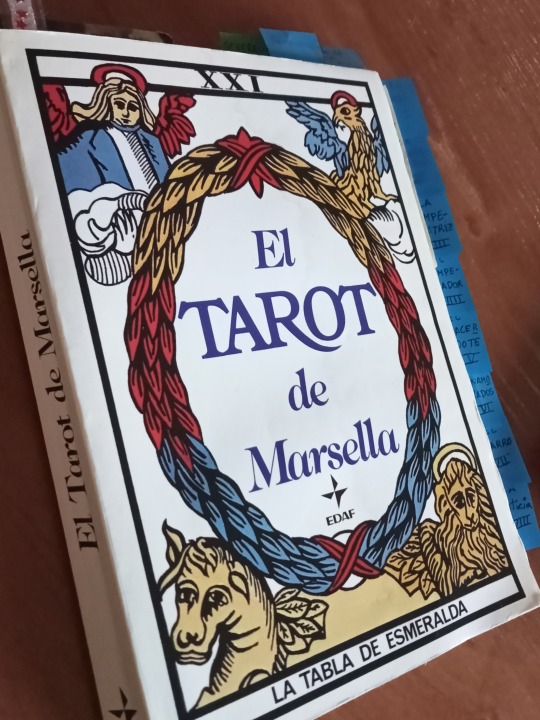
View On WordPress
0 notes
Text


Tarot card figures from Court de Gebelin's Monde
primitif (1781): the High Priestess; the High Priest; the Chariot; the Lovers.
43 notes
·
View notes
Text
Tarocchi & Gebelin

Singer, S. Weller., Triphook, R., Thordarson Collection. (1816).Researches into the history of playing cards: with illustrations of the origin of printing and engraving on wood. London: Printed by T. Bensley and Son for Robert Triphook.
1 note
·
View note
Text
weekly roundup
what i’ve been reading
On The Tarot by Antoine Court de Gebelin
I got a bunch of cool digital comics from the ShortBox Comics Fair. The ones I’ve read so far:
- Baby, You Are Fine by Disa Wallander
- Chamber By Chamber by Ryugure
what i watched
started Akiba Maid Wars -- delightfully insane anime where a bunch of rival maid cafes are separate turfs in a cutesy maid mafia... it’s unhinged and I loved it
Modest Heroes -- the first short gets points for animating a super normal fish into looking like a terrifying monster, but the last two shorts are where the anthology really shined
Blown Away season 1 -- Netflix’s random glassblowing competition series. we got very invested...!!
You Will Not Be Alone (movie, 2022) -- such an interesting film... gave me some very specific mom and abuse survivor feelings. beautiful ending. gorey as hell throughout lol
games played
beginning of Unraveled
a LOT of Inscryption -- it’s fun as fuck and cool as fuck
Rayman 3 -- boyfriend’s obscure favorite game <3
youtube highlights
The Happy Ending of PT by Leadhead
favorite songs of the week
Juice - Lizzo
also learned about a really cool website called Radio Garden where you can browse radio stations all around the world by location
0 notes
Text
i want to write about some thoughts i’m having today after watching a video essay about the history of the new age movement and my own journey with my religious beliefs alongside that. i want to dissect the ethics of it, where it aligns with my own morals, and reflect on it.
while i mostly use twitter for all my casual stuff, tumblr is the better format for me to share my more expanded thoughts so i’m going to do that here
i think i want to start with looking into the history of tarot cards since i use them more frequently than any other occult / "new age" tool (i dont know how else to refer to it).
from what i understand, tarot originated in the 1400′s in france and italy with the playing cards as we know them (the four suits) with the addition of a fifth suit known as trumps or triumphs (link; using this article for other notes too- i have some mild concerns about the credibility of this site but for now i will be referencing it). the following paragraph is under the heading "tarot and kabbalah" which i want to dig into more since 'kabbalah' is a jewish principal / teaching and thus i want to examine the ties of tarot with kabbalah and the possible antisemitism/appropriation in that.
In 1781, a French Freemason (and former Protestant minister) named Antoine Court de Gebelin published a complex analysis of the Tarot, in which he revealed that the symbolism in the Tarot was in fact derived from the esoteric secrets of Egyptian priests. De Gebelin went on to explain that this ancient occult knowledge had been carried to Rome and revealed to the Catholic Church and the popes, who desperately wanted to keep this arcane knowledge secret. In his essay, the chapter on Tarot meanings explains the detailed symbolism of Tarot artwork and connects it to the legends of Isis, Osiris and other Egyptian gods.
obviously i find this concerning from the get go since, you know, this is a protestant claiming these things with no basis. the article does mention this too, and brings up another figure in the history of tarot developing from a parlor game to a tool for divination in occult.
In 1791, Jean-Baptiste Alliette, a French occultist, released the first Tarot deck designed specifically for divinatory purposes, rather than as a parlor game or entertainment. A few years earlier, he had responded to de Gebelin’s work with a treatise of his own, a book explaining how one could use the Tarot for divination.
my first question when i was thinking about tarot was who exactly did the tarot originate with? and by that i was wondering if it originated with the romani. from my understanding tarot as it is practiced in modern day by many pagans and wiccans did in many ways but not... completely? i found this reddit thread about it wherein someone is positing these questions, a romani person says that tarot is a closed tradition, but a jewish person also states that they're uncomfortable being accused of cultural appropriation since the modern idea/"mainstream" way tarot is used today is also rooted in the kabbalah which is jewish in practice and nature. the first article i linked mentions this only slightly in that the imagery of the rider-waite is kabbalistic symbolism.
the video that got me thinking about this question is by a youtube channel called "we're in hell" (video link). in the comment section there is this written by an account called ausernamegoeshere which expands upon what kabbalah is:
I think that it is important when discussing a topic like this where Kabbalah keeps coming up that it be acknowledged that the Kabbalah that is mentioned here is not actually Kabbalah. Rather it is a form of Kabbalah that has been culturally appropriated from Judaism, Jewish culture, and the Jewish people. Kabbalah is a form of Torah learning that has an extremely deep and intense nature and focuses on meditation, and reality, the theoretical, and "Olam Hazeh" This World and the spiritual realm, the soul, and “Olam Haba” The World To Come. It is understood because of the complex nature of concepts studied in Kabbalah that the person studying it can become mentally unstable, as it is discussed and documented in Jewish history of people “losing their minds” when studying Kabbalah. This is why for as long as Kabbalah has existed so has the requirements to study it. There are three requirements to study Kabbalah and they 1) the person must be Jewish 2) the person must be 40 years of age or older 3) the person must be very learned in Torah. All three requirements have to be fulfilled in order to study Kabbalah. Like I said, I think all of this is important to acknowledge or mention when you have a topic where Kabbalah keeps coming up.
i don't know the validity to any of this, though. i don't know any jewish scholars i could refer to at the moment about it. for now, i will be operating under the function that this information is true. if so, then tarot seems to be both interconnected with the romani and jewish people. additionally, if the above is also true, then the imagery of the rider-waite deck alone is, i guess, a bastardization of the jewish kabbalah practice.
arthur waite was not jewish. the artist of the rider-waite deck was pamela colman smith and through the article on learnreligions, i found one about her here. according to this article, she was a biracial jamacian-american woman. here is another article about her, but not a lot is known about her considering even her name is omitted from the title of the deck. according to the second article linked in this paragraph, she was the first to illustrate more complex images for all the minor suits of the tarot deck and also attributed her own ideas for the meanings which- in my opinion- gives a slight degree of separation. however, the reddit thread itself and some other questions expressed elsewhere- as well as within myself- is if cartomancy in any form is cultural appropriation.
while also searching, i found this article by a site 'occultivated' discussing how they would stop using tarot cards and transition to oracle decks because of its ties to the cultural appropriation to the romani. i'm listing this article mostly as a real world example of this exact question i'm asking myself currently.
in the reddit thread i linked the asker is positing similar questions that i am asking myself, and also notes that there's not a whole lot of readily available or accessible information about this online. i don't know any romani people i can speak to about it. the asker says in part of their post:
Being that their religious practices are closed and that power dynamics exist, there are Romani who have stated that (a) nonRomani should not practice Tarot, (b) that nonRomani people may practice tarot but should avoid spreads / a certain way of read that hold great religious meaning to Romani (most of which nonRomani likely not exposed to), (c) that the power dynamic matters, so while it’s still technically appropriation for nonwhite nonRomani to read Tarot, they are comfortable giving that other groups have been oppressed in a way as to have their spiritual practices taken away from them.
a romani person in the reddit threads says they believe it is cultural appropriation and suggests the use of oracle cards. however, there are some romani who believe cartomancy in any form is cultural appropriation. with this in mind, i still feel a moral quandary about it.
given the imagery of the well-known rider-waite deck is intertwined with jewish symbolism and the kabbalah, but it was also created by a jamacian-american woman who also wove her own thoughts and meanings into some cards, is the deck evolved enough on its own to stand separate from these cultural traditions? probably not, but it bares to think about all of that together. there's a lot of cultural things coming together in the creation of the rider-waite deck and this deck laid a lot of foundational work for how tarot is practiced among pagans and wiccans today.
how divorced is it from the romani practices? how divorced is it from jewish symbolism and faith? i don't know. im not jewish or romani, so i dont think i can answer. my quandary still remains because there seems to be no big, i suppose, consensus or larger agreement/understanding of what the answer could be- or if there is one, i am not aware of it/havent found it/havent heard it.
i think it also bares worth considering, in this question im asking myself, how i function with it in my own practice. by no means am i deeply experienced or anything. i've really only been working with my tarot deck for, id guess, eight or so months? i didnt really have any guide i followed in particular, either.
my first deck was one i bought spur of the moment before i even began more deeply exploring being a pagan. it's a relatively good deck and i feel it communicates well with me. i got my own copy of a rider-waite deck this past summer. sometime in july i think? or june. anyway. i like it a lot as well, ive done two readings with it and it communicated fantastically with me.
i dont use either of my decks, nor would i in general, use them to tell the future or anything like that. i use them when i feel i need guidance, really. things like- what should i ask myself in this moment, in what ways can i grow, i use them when i am seeking to communicate with the Goddess i work with, Isis. when i need to let go or be patient, etc. they've been a great tool for me in my personal reflection and finding a more fulfilled sense of self. they're also, honestly, the only tool i have at my disposal to communicate with Isis at length considering i am kinda just... winging all this. if She has sent me signs in other ways then admittedly it is because i am too inexperienced to notice them, but with my tarot decks i can ask a question and get an answer in a way thats easier for me to comprehend/understand.
am i willing to give this up, or to look for other options? am i willing to try an oracle deck? is it ethical for me to try an oracle deck let alone continue using my current two tarot decks?
i dont know. im trying to figure that out, i guess. even after writing all of this im not sure.
even now im finding myself wanting to meditate and ask Isis for guidance on the matter- but i only have one way to do that where i know how to interpret the signs.
a new addition: i looked more into the reddit thread ive link, and another post further in one of the comment sections linked to a website that dissected the history of tarot fairly well, i think. the site is currently unavailable, but using the waybackmachine i was able to recover its information here.
the article discusses how tarot as we know it came to be. the first playing cards originated from korea and china in 900AD and were introduced to many islamic societies through the silk road, and from there- specifically, through egypt, the first playing cards came to europe in the form of the mamluk deck.
the article makes a fantastic point, i think, which is "Claiming then that tarot is a closed practice or its use is an instance of cultural appropriation denies the true history of the cards and plays into the same eroticist fiction that the likes of de Gebelin and Etteilla were peddling over two-hundred years ago."
the article goes even further, and talks about how tarot inevitably did become so intertwined with the romani culture. im going to copy paste large parts of this article here onto my blog because i really do appreciate how well its articulated and how well it answers my questions
“There are a lot of stereotypes about us being magical and fortune tellers but this all comes from when we weren’t allowed to take regular jobs. So a lot of Romani women told fortunes to provide for their families” explains Romani activist Juni (@romaniuprising). “Because of this, practices such as palmistry and Tarot reading have become a part of our culture because for so long it was the only way for us to provide for ourselves”.
Regina, an activist who works to preserve Roma culture (@roma.culture) echoed Juni’s words. “Factually, Tarot reading doesn’t have Roma origins” she begins. “But it does hold a special place in our culture… it’s fascinating to think how some of these practices like fortune telling, palmistry, and Tarot reading still exist today and how the women in our community continue to teach these to their daughters and nieces”.
Regardless of its origins and whether by choice or not, tarot has clearly over the years become one of many important Dukkering (Romani fortune-telling) tools for the Romani people that holds significance for many as part of a varied and complex culture.
But Juni points out that this doesn’t mean tarot as a tool or tarot reading as a practice is perceived to be ‘closed’ to people outside of Romani culture. “All we want is recognition that it’s a part of our culture”.
it also discusses how the intertwining of jewish imagery and symbolism! i really deeply appreciate how this article not only goes into the history of how tarot came to be, but also encourages the readers of the article to still learn and be considerate to how tarot developed and the cultures that did become intertwined with it (the romani and the jewish). the article also discusses appropriation in the current day among pagan/witch/wiccan circles, specifically the appropriation of native and indigenous peoples (in this case they list some tarot decks that do this since the article is about tarot). im adding the source list as well from the article in case i want to further look into any of these own books for my own research/learning.
It is also important to understand the significance of the symbols used in tarot decks. Zo (@jewitches) is a hereditary Jewish witch who works to educate people about Judaism and highlight appropriation of Jewish culture. “Jewish religious practices, culture, and beliefs are frequently bastardized by the occult community, in new and improved ways even in the modern-day” she explains. “In an effort to make tarot seem like it had an ancient, mystical background, white occultists cherry picked from Jewish culture to legitimize their practice with the cards”.
Zo outlined how this manifests itself in tarot specifically. “Jewish symbolism, even as badly appropriated as it is, causes real harm to Jewish communities and people. The basic misunderstandings of Judaism on a theological and cultural basis, paired with the presence of sacred Jewish symbols like the Priestly Blessing on the Devil card or the ineffable name of G-d [many Jewish people refer to the Jewish deity as G-d as it’s considered disrespectful to write the name down somewhere it could be destroyed] on the Wheel of Fortune, inextricably links Judaism to a divination system that originated outside of our culture. This leads to aggressive anti-Semitism that mirrors that of the medieval age with ideas like, ‘Jews are devils, Jews are evil, Jews are nefarious sorcerers, and Jews run the world’".
Appropriated Jewish imagery is so enmeshed in many classic tarot decks, including Rider-Waite-Smith (the first deck created exclusively for divination and the most popular tarot deck in existence), that Zo contends it’s impossible to extricate. “The best we can do is ask that occultists educate themselves on Judaism, the differences between true Kabbalah and appropriated variations, and how anti-Semitism flourishes in their communities”.
Sources
This article is only a short introduction to this complex and vast topic. Here are some books I would recommend you engage with too. I don’t endorse the views of all of them but they offer multiple perspectives on Tarot that have all been impactful on discourse.
A Cultural History of Tarot by Helen Farley
Mystical Origins of the Tarot by Paul Huson
A History of the Occult Tarot by Michael Dummett and Ronald Decker
The Esoteric Tarot by Ronald Decker
Holistic Tarot by Benebell Wen
Cartomancy in Bologna by Michael Dummett (published in volume 32 of The Playing Card)
Seventy Eight Degrees of Wisdom by Rachel Pollack
with all this new information now in mind, i think i do feel much more- i suppose- resolved in my quandaries. i think my best coarse of action is probably to go back to only using my original deck and not using my rider-waite deck. i do want to get another deck cause while i like my second one a lot, i feel it often gives me more complex answers that i am just not skilled enough to read yet. it can be quite hard for me to decipher at times. i think what i'll do is look into getting another deck and also research its artists/creators and the imagery in order to be as considerate as possible in my practice.
0 notes
Text
¿Hay un tarot vintage? Veamos la historia del tarot
La historia de las cartas del tarot. El origen del tarot ¿Hay un tarot vintage? Veamos la historia del tarot… ¿Cuál es el origen de las cartas del tarot? Siempre que oímos hablar de las cartas del tarot inmediatamente pensamos en la adivinación, pero de hecho, la costumbre de las lecturas del tarot se remonta al siglo XVIII, cuando los lectores de tarot Court de Gebelin y Aliette comenzaron a llevarlas a cabo y dejaron constancia de ello en Francia. Es curioso comprobar cómo hoy en día incluso encontramos consultas de tarot baratas gracias a la Red. El origen del…
from DE JOHNNY ZURI via johnnyzuri on Inoreader https://ift.tt/grJdRws
0 notes
Text
About Court de Gebelin Read This One
About Court de Gebelin Read This One
Court de Gebelin Read This One
Antoine Court de Gebelin
Court de Gebelin is confusing among the new and the more experienced Tarot Readers. I want to help you understand him and his work. Hopefully, we can all get on the same page and let go of our bias regarding this man and his contribution to the Tarot.
Of the Game of the Tarot – Court de Gebelin
Of the Game of the Tarot – Court de…

View On WordPress
#Court de Gebelin#Court de Gebelin allegories#Court de Gebelin Read This One#Egyptian Tarot Book#Game of the tarot
0 notes